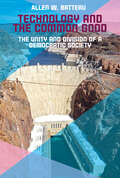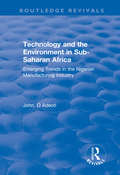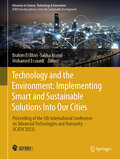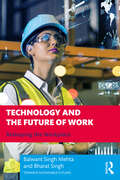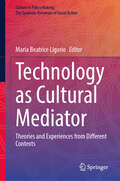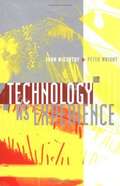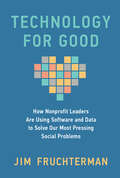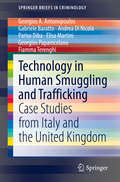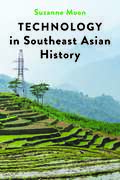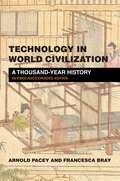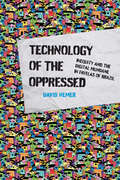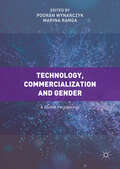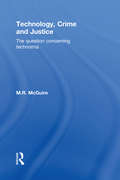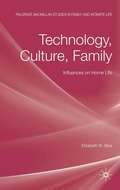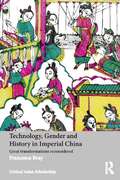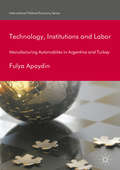- Table View
- List View
Technology and the Common Good: The Unity and Division of a Democratic Society
by Allen BatteauBuilding on the work of Elinor Ostrom (Governing the Commons) the author examines how the different shared goods of a democratic society are shaped by technology and demonstrates how club goods, common pool resources, and public goods are supported, enhanced, and disrupted by technology. He further argues that as the common good is undermined by different interests, it should be possible to reclaim technology, if the members of the society conclude that they have something in common.
Technology and the Culture of Progress in Meiji Japan (Routledge/Asian Studies Association of Australia (ASAA) East Asian Series)
by David G. WittnerIn this book David Wittner situates Japan’s Meiji Era experience of technology transfer and industrial modernization within the realm of culture, politics, and symbolism, examining how nineteenth century beliefs in civilization and enlightenment influenced the process of technological choice. Through case studies of the iron and silk industries, Wittner argues that the Meiji government’s guiding principle was not simply economic development or providing a technical model for private industry as is commonly claimed. Choice of technique was based on the ability of a technological artifact to import Western "civilization" to Japan: Meiji officials’ technological choices were firmly situated within perceptions of authority, modernity, and their varying political agendas. Technological artifacts could also be used as instruments of political legitimization. By late the Meiji Era, the former icons of Western civilization had been transformed into the symbols of Japanese industrial and military might. A fresh and engaging re-examination of Japanese industrialization within the larger framework of the Meiji Era, this book will appeal to scholars and students of science, technology, and society as well as Japanese history and culture.
Technology and the Environment in Sub-Saharan Africa: Emerging Trends in the Nigerian Manufacturing Industry (Routledge Revivals)
by John. O AdeotiThis title was first published in 2002. Why do firms adopt pollution control technologies? How can environmental policy be strengthened? How can technology and industrial policies achieve green innovation? This volume critically examines whether the "stimulus-response" notion of environmental policy functions as the primary motivation for the adoption of pollution control technologies. It also questions whether technology and industrial policies can help to achieve the objective of green innovation. Interesting and well-researched empirical case studies offer important insights into the observed trends in the quantitative analysis. Focusing in particular on Nigerian industry, John Adeoti exposes the gains from and constraints upon firms' technology investment in pollution control.
Technology and the Environment in Sub-Saharan Africa: Emerging Trends in the Nigerian Manufacturing Industry (Routledge Revivals)
by John. O AdeotiThis title was first published in 2002. Why do firms adopt pollution control technologies? How can environmental policy be strengthened? How can technology and industrial policies achieve green innovation? This volume critically examines whether the "stimulus-response" notion of environmental policy functions as the primary motivation for the adoption of pollution control technologies. It also questions whether technology and industrial policies can help to achieve the objective of green innovation. Interesting and well-researched empirical case studies offer important insights into the observed trends in the quantitative analysis. Focusing in particular on Nigerian industry, John Adeoti exposes the gains from and constraints upon firms' technology investment in pollution control.
Technology and the Environment: Proceeding of the 5th International Conference on Advanced Technologies and Humanity (ICATH’2023) (Advances in Science, Technology & Innovation)
by Mohamed Essaaidi Brahim El Bhiri Saliha AssoulThis book presents a collection of research papers and case studies from leading experts in the field. This proceedings book explores innovative approaches to addressing environmental challenges in urban settings through the integration of technology and sustainability. From mapping urban flood hazards to leveraging artificial intelligence in e-learning and financial fraud detection, each paper offers practical insights and solutions for implementing smart and sustainable practices in cities. Case studies examine the impact of new urban spaces on human behavior, the role of digital communication in local governance, and the potential of renewable energy transition in reshaping Morocco's energetic future. Readers will gain valuable insights into topics such as smart tourism strategies, modeling solar wood drying, evaluating geothermal potential, and optimizing energy systems through machine learning algorithms and renewable energy integration. With contributions covering a wide range of topics, "Technology and The Environment" serves as a valuable resource for researchers, practitioners, policymakers, and students interested in harnessing technology to create more sustainable urban environments.
Technology and the Future of Work: Reshaping the Workplace (Towards Sustainable Futures)
by Bharat Singh Balwant Singh MehtaThis book examines how the progress of digital technology is transforming the world of work, skill demand, labour market institutions, and regulations in countries like India. It studies the challenges, opportunities, and current and future contributions of digital technologies. The volume poses salient questions regarding the ICT sector, I4.0 technologies, the gig economy, remote work, and the regulatory environment, and interrogates the policy and regulatory measures needed to promote more inclusive and decent work in the future.Part of the Towards Sustainable Futures series, this book will be an essential read for scholars and researchers of economics, sustainable development, sociology of work, labour economics, Indian economy, public policy, and human resource management. It will also be extremely useful to policymakers, government organisations, civil society organisations, and those in the corporate sector.
Technology and the Intelligence Community: Challenges And Advances For The 21st Century (Advanced Sciences and Technologies for Security Applications)
by Margaret E. KosalThis volume examines the role of technology in gathering, assimilating and utilizing intelligence information through the ages. Pushing the boundaries of existing works, the articles contained here take a broad view of the use and implementation of technology and intelligence procedures during the cold war era and the space race, the September 2011 attacks, and more recent cyber operations. It looks at the development of different technologies, procedural implications thereof, and the underlying legal and ethical implications. The findings are then used to explore the future trends in technology including cyber operations, big data, open source intelligence, smart cities, and augmented reality. Starting from the core aspects of technical capabilities the articles dig deeper, exploring the hard and soft infrastructure of intelligence gathering procedures and focusing on the human and bureaucratic procedures involved therein.Technology and innovation have played an important role in determining the course of development of the intelligence community. Intelligence gathering for national security, however, is not limited only to the thread of technical capabilities but is a complex fabric of organizational structures, systemic undercurrents, and the role of personnel in key positions of decision making. The book’s findings and conclusions encompass not just temporal variation but also cut across a diverse set of issue areas. This compilation is uniquely placed in the interdisciplinary space combining the lessons from key cases in the past to current developments and implementation of technology options.
Technology as Cultural Mediator: Theories and Experiences from Different Contexts (Culture in Policy Making: The Symbolic Universes of Social Action)
by Maria Beatrice LigorioThis volume explores the relationship between humans and technology across a variety of contexts, with particular attention to how technology mediates interactions between individuals. It considers a wide range of settings, including education and training, professional and entertainment environments, as well as social, artistic, and economic domains. Drawing on diverse theoretical frameworks, the volume presents research conducted in several countries. Key themes addressed here include edutainment and the future of learning; immersive experiences and their influence on human engagement with art and cultural heritage; digital and AI-mediated platforms, and the evolving on dynamics of human-human and human-machine interaction, including human-robot interaction. The volume opens with a historical and cultural overview of the human-technology relationship, and each chapter presents original empirical data alongside a review of relevant research and developments within its specific field. This structure enables readers to gain both a historical perspective and insights into emerging trends. A unifying thread throughout the volume is the focus on the cultural dimension of technology, contributing to the discussion about whether technology creates new culture or the current culture creates technology. It also discusses associated social and digital policies and potential future directions technology may take. It provides critical reflections on a rapidly evolving field of study. The volume will be of interest to a broad audience of scholars and researchers engaged in the study of human-technology interaction and the development of related policies.
Technology as Experience
by Peter Wright John MccarthyJohn and Peter argue that any account of what is often called the user experience must take into consideration the emotional, intellectual, and sensual aspects of our interactions with technology. We don't just use technology, they point out; we live with it.
Technology as Human Social Tradition
by Peter JordanTechnology as Human Social Tradition outlines a novel approach to studying variability and cumulative change in human technology--prominent research themes in both archaeology and anthropology. Peter Jordan argues that human material culture is best understood as an expression of social tradition. In this approach, each artifact stands as an output of a distinctive operational sequence with specific choices made at each stage in its production. Jordan also explores different material culture traditions that are propagated through social learning, factors that promote coherent lineages of tradition to form, and the extent to which these cultural lineages exhibit congruence with one another and with language history. Drawing on the application of cultural transmission theory to empirical research, Jordan develops a descent-with-modification perspective on the technology of Northern Hemisphere hunter-gatherers. Case studies from indigenous societies in Northwest Siberia, the Pacific Northwest Coast, and Northern California provide cross-cultural insights related to the evolution of material culture traditions at different social and spatial scales. This book promises new ways of exploring some of the primary factors that generate human cultural diversity in the deep past and through to the present.
Technology for Good: How Nonprofit Leaders Are Using Software and Data to Solve Our Most Pressing Social Problems
by Jim FruchtermanA visionary guide to using technology for positive social change, from a MacArthur genius awardee, former rocket engineer, and passionate leader in the social enterprise movement. <p> The accepted wisdom in big business is that the only worthy ideas are ones that make a lot of money, preferably billions. But Jim Fruchterman believes there is a different path for technology. What if tech returned to its roots and made people more effective and powerful? What if the benefits of technology came to the 90 percent of humanity traditionally neglected by for-profit companies in favor of immense profits gained by focusing on the richest 10 percent? <p> In Technology for Good, Fruchterman explores that question and delivers a comprehensive how-to for leaders who want to create, expand, join, support, and improve organizations that see building technology as a key element of delivering on their social good mission. The author makes a strong case that tech is required for social change at scale. He then offers guidance on how to structure, fund, staff, manage, scale, and sustain nonprofits that leverage technology for social good. The book includes actionable, proven practices; compelling case studies of nonprofits that have “cracked the code” on tech for good; and Fruchterman’s own stories of what he has learned as a tech-for-good entrepreneur. <p> With 80 percent of the examples in the book from organizations and individuals outside the US, Technology for Good is a call to action with a genuinely global focus, blazing a path toward a future in which human beings come rightly and justly before profits.
Technology for Societal Transformation: Exploring the Intersection of Information Technology and Societal Development
by Lawal O. Yesufu Puteri Nor Ellyza NohuddinThis book extensively investigates the dynamic relationship between information technology and societal transformation. The book explores a range of applied IT uses, ranging from educational technology to the complex applications of cybersecurity, the promise of blockchain technologies, e-commerce and rural development, and social media and its applications in political activism. Investigating key topics in social development and the role information technology plays in elevating our lives, the book navigates this ever-changing landscape of technological innovation to determine how it can be a source for good and improve our lives by driving positive social change. While focusing on the practical application of technology to real-world situations, examples, and cases, the book primarily focuses on educational development, entrepreneurship, sociopolitical transformation, and the security and defence of society. Collectively, these explorations serve to better highlight how technology can be harnessed in the creation of a more inclusive and equitable society. Hence, the book will be a useful read for students, academics, policymakers, business and social investors.
Technology in Human Smuggling and Trafficking: Case Studies from Italy and the United Kingdom (SpringerBriefs in Criminology)
by Georgios A. Antonopoulos Georgios Papanicolaou Andrea Di Nicola Fiamma Terenghi Gabriele Baratto Parisa Diba Elisa MartiniThis brief offers a unique and innovative account of the role of internet and digital technologies in human smuggling and trafficking. It explores new illegal paths through the web by analyzing how traffickers and smugglers use the visible and dark web during different phases of the process, including recruitment, transportation, and exploitation. Featuring case studies from two European countries, Italy and the United Kingdom, it outlines the types of websites used in these processes, how they are used, and common behavior patterns. With a view of transnational criminal activities involving actors from individual criminal entrepreneurs to organized crime groups and fluid large criminal networks, this brief will be of use to law enforcement, researchers of trafficking and organized crime, and policy makers.
Technology in Social Work Education and Curriculum: The High Tech, High Touch Social Work Educator
by Florence W Vigilante Richard L Beaulaurier Martha F HaffeySave time and trouble as you incorporate technology into your social work curriculumThe dramatic increase in the use of computers and other forms of technology in social work education and practice has educators, trainers, and administrators investing valuable time, money, and effort into trying to make the transition from traditional teaching to a Web-assisted learning environment. Technology in Social Work Education and Curriculum takes the mystery out of the online experience with practical information on using technology to enhance and enrich learning-but not at the expense of the "human" approach to social work. This unique book presents a variety of creative and interesting methods for incorporating technology that&’s affordable and user-friendly, and for developing online skills that won&’t become obsolete as computer hardware and software evolves.Technology in Social Work Education and Curriculum transforms technology into an everyday resource for agency field instructors, human service educators, trainers, and social work administrators. The book addresses concerns that educators with limited technical skills may have in using technology to teach cultural competency, group work, research, direct practice, social policy and advocacy, and field practicum, presenting hands-on approaches that are innovative but accessible. And by focusing on approaches rather than simply reviewing available hardware and software, the book provides you with background knowledge that makes it easier for you to successfully incorporate online learning into the classroom. Technology in Social Work Education and Curriculum examines using instructional technology to emotionally engage students in the learning process using digital video and qualitative data analysis software to teach group practice the role technology plays in advocacy distance-education technologies in policy education incorporating Web-assisted learning into a traditional classroom setting the advantages of distance education over more conventional approaches a model for planning the use and integration of computer technology in schools of social work how the behaviors of computer consultants can affect the students who seek their help using innovation diffusion theory in technology planning and much more!Social workers have traditionally embraced the latest technologies and scientific developments since the earliest days of the profession. Technology in Social Work Education and Curriculum helps continue that tradition, offering invaluable guidance to educators and administrators, no matter how experienced-or inexperienced-they are in dealing with communications technologies.
Technology in World Civilization, revised and expanded edition: A Thousand-Year History
by Francesca Bray Arnold PaceyThe new edition of a milestone work on the global history of technology.This milestone history of technology, first published in 1990 and now revised and expanded in light of recent research, broke new ground by taking a global view, avoiding the conventional Eurocentric perspective and placing the development of technology squarely in the context of a "world civilization." Case studies include "technological dialogues" between China and West Asia in the eleventh century, medieval African states and the Islamic world, and the United States and Japan post-1950. It examines railway empires through the examples of Russia and Japan and explores current synergies of innovation in energy supply and smartphone technology through African cases.The book uses the term "technological dialogue" to challenges the top-down concept of "technology transfer," showing instead that technologies are typically modified to fit local needs and conditions, often triggering further innovation. The authors trace these encounters and exchanges over a thousand years, examining changes in such technologies as agriculture, firearms, printing, electricity, and railroads. A new chapter brings the narrative into the twenty-first century, discussing technological developments including petrochemicals, aerospace, and digitalization from often unexpected global viewpoints and asking what new kind of industrial revolution is needed to meet the challenges of the Anthropocene.
Technology in World Civilization: A Thousand-Year History
by Arnold PaceyMost general histories of technology are Eurocentrist, focusing on a main line of Western technology that stretches from the Greeks is through the computer. In this very different book, Arnold Pacey takes a global view, placing the development of technology squarely in a "world civilization." He portrays the process as a complex dialectic by which inventions borrowed from one culture are adopted to suit another.Arnold Pacey is a physicist turned historian whose publications have contributed to the British appropriate-technology movement. He has written widely on science, technology, and agriculture. His previous books include The Maze of Ingenuity and The Culture of Technology.
Technology of the Oppressed: Inequity and the Digital Mundane in Favelas of Brazil (The Information Society Series)
by David NemerHow Brazilian favela residents engage with and appropriate technologies, both to fight the oppression in their lives and to represent themselves in the world. Brazilian favelas are impoverished settlements usually located on hillsides or the outskirts of a city. In Technology of the Oppressed, David Nemer draws on extensive ethnographic fieldwork to provide a rich account of how favela residents engage with technology in community technology centers and in their everyday lives. Their stories reveal the structural violence of the information age. But they also show how those oppressed by technology don&’t just reject it, but consciously resist and appropriate it, and how their experiences with digital technologies enable them to navigate both digital and nondigital sources of oppression—and even, at times, to flourish. Nemer uses a decolonial and intersectional framework called Mundane Technology as an analytical tool to understand how digital technologies can simultaneously be sites of oppression and tools in the fight for freedom. Building on the work of the Brazilian educator and philosopher Paulo Freire, he shows how the favela residents appropriate everyday technologies—technological artifacts (cell phones, Facebook), operations (repair), and spaces (Telecenters and Lan Houses)—and use them to alleviate the oppression in their everyday lives. He also addresses the relationship of misinformation to radicalization and the rise of the new far right. Contrary to the simplistic techno-optimistic belief that technology will save the poor, even with access to technology these marginalized people face numerous sources of oppression, including technological biases, racism, classism, sexism, and censorship. Yet the spirit, love, community, resilience, and resistance of favela residents make possible their pursuit of freedom.
Technology, Commercialization and Gender
by Pooran Wynarczyk Marina RangaThis timely collection seeks to advance our understanding of the role of women in technology commercialization. Widely acknowledged as the fundamental components of economic prosperity and global competitiveness, current literature on the management of technological change focuses on processes and institutions and neglects to address gender dimensions. Responding to this pressing need to critically examine women's participation and contribution, Technology, Commercialization and Gender addresses the construction of gendered identities within predominantly male-dominated work environments such as technology transfer, patenting, licensing and management of Intellectual Property Rights and R&D. With contributions from globally renowned scholars this important book aims to broaden the current understanding of the dynamics and implications of this phenomenon and as such, seeks to address gaps in knowledge at an international level.
Technology, Crime and Justice: The Question Concerning Technomia (Routledge International Handbooks Ser.)
by Michael McGuireAs technology comes to characterize our world in ever more comprehensive ways there are increasing questions about how the 'rights' and 'wrongs' of technological use can be adequately categorized. To date, the scope of such questions have been limited – focused upon specific technologies such as the internet, or bio-technology with little sense of any social or historical continuities in the way technology in general has been regulated. In this book, for the first time, the 'question of technology' and its relation to criminal justice is approached as a whole. Technology, Crime and Justice analyzes a range of technologies, (including information, communications, nuclear, biological, transport and weapons technologies, amongst many others) in order to pose three interrelated questions about their affects upon criminal justice and criminal opportunity: to what extent can they really be said to provide new criminal opportunity or to enhance existing ones? what are the key characteristics of the ways in which such technologies have been regulated? how does technology itself serve as a regulatory force – both in crime control and social control more widely? Technology, Crime and Justice considers the implications of contemporary technology for the practice of criminal justice and relates them to key historical precedents in the way technology has been interpreted and controlled. It outlines a new ‘social’ way of thinking about technology – in terms of its affects upon our bodies and what they can do, most obviously the ways in which social life and our ability to causally interact with the world is ‘extended’ in various ways. It poses the question – could anything like a ‘Technomia’ of technology be identified – a recognizable set of principles and sanctions which govern the way that it is produced and used, principles also consistent with our sense of justice? This book provides a key resource for students and scholars of both criminology and technology studies.
Technology, Culture, Family
by Elizabeth B. SilvaThis book examines connections between personal, relational and material matters in everyday life in the context of broader and long standing social problems. It explores the connections between mundane practices in the reproduction of our bodies and our relations with those we live with, and the technological practices that inform daily life.
Technology, Defense, And External Relations In China, 1975-1978
by Harry G. GelberThis volume surveys efforts by China's post-Mao leadership to adopt modern technology in China's industrial and economic sectors while focusing new attention on an increasingly obsolescent defense structure. The author presents these efforts against the background of the external political and military environment to which the PRC must react. He outlines the foreign policy and strategic problems that faced the new administration as it came to power in Peking and examines the military, industrial, and technical resources currently at China's disposal as well as changes that have been proposed, implemented, or that may be required in the future. Finally, he suggests some of the limitations circumscribing government policy in these areas and some of the choices that lie ahead.
Technology, Energy, and Health (Entering the Shift Age, eBook #6)
by David HouleWe are leaving the Information Age and transitioning into the Shift Age, a time of transformation and change that offers both great risk and incredible opportunity. In Entering the Shift Age, David Houle identifies and explains the dynamics and forces that have shaped our world and will continue to reshape our world for the next 20 years. He shows how the Shift Age means a world fully global yet focused on the individual, where the speed of change is so fast that change itself is the new norm. He also comments from the front lines of the Shift Age on issues and topics that affect our lives, from business and technology to environment, media and global culture. eBook 6 looks at three of the most significant areas of change in the Shift Age, offering a high-level tour of the major changes and trends in technology, energy, medicine, and health management.
Technology, Gender and History in Imperial China: Great Transformations Reconsidered (Asia's Transformations/Critical Asian Scholarship)
by Francesca BrayWhat can the history of technology contribute to our understanding of late imperial China? Most stories about technology in pre-modern China follow a well-worn plot: in about 1400 after an early ferment of creativity that made it the most technologically sophisticated civilisation in the world, China entered an era of technical lethargy and decline. But how are we to reconcile this tale, which portrays China in the Ming and Qing dynasties as a dying giant that had outgrown its own strength, with the wealth of counterevidence affirming that the country remained rich, vigorous and powerful at least until the end of the eighteenth century? Does this seeming contradiction mean that the stagnation story is simply wrong, or perhaps that technology was irrelevant to how imperial society worked? Or does it imply that historians of technology should ask better questions about what technology was, what it did and what it meant in pre-modern societies like late imperial China? In this book, Francesca Bray explores subjects such as technology and ethics, technology and gendered subjectivities (both female and male), and technology and statecraft to illuminate how material settings and practices shaped topographies of everyday experience and ideologies of government, techniques of the self and technologies of the subject. Examining technologies ranging from ploughing and weaving to drawing pictures, building a house, prescribing medicine or composing a text, this book offers a rich insight into the interplay between the micro- and macro-politics of everyday life and the workings of governmentality in late imperial China, showing that gender principles were woven into the very fabric of empire, from cosmology and ideologies of rule to the material foundations of the state and the everyday practices of the domestic sphere. This authoritative text will be welcomed by students and scholars of Chinese history, as well as those working on global history and the histories of gender, technology and agriculture. Furthermore, it will be of great use to those interested in social and cultural anthropology and material culture.
Technology, Institutions and Labor: Manufacturing Automobiles In Argentina And Turkey (International Political Economy Ser)
by Fulya ApaydinIn this book Fulya Apaydin argues that labor responses to dramatic technological change are influenced by the political institutions of the Global South more than any other factor. In addressing vocational education programs – which are highly relevant in understanding how labor unrest is governed in developing settings – she makes two important contributions. Firstly, she offers a new theoretical framework to understand labor mobilization and de-mobilization patterns, rethinking vocational education as a key transmission belt for manufacturing labor consent. Secondly, she provides a systematic comparison of skill formation schemes and their implications on labor mobilization in federal and unitary systems. With a focus on Argentina and Turkey, two case studies are provided in which technology has provoked differing levels of strikes, walkouts and extended protest.
